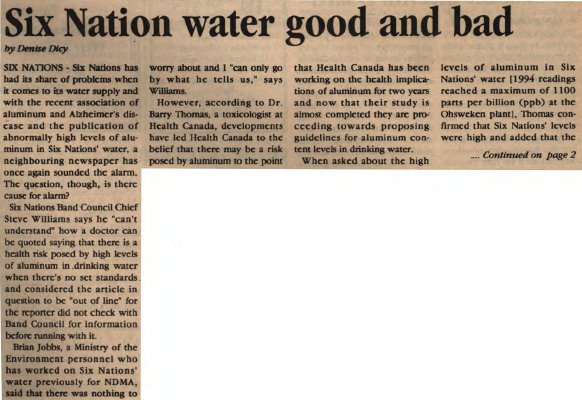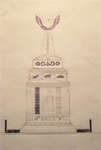"Six Nation water good and bad"
- Publication
- Tekawennake News (Ohsweken, Ontario), 19 Apr 1995, pp.1-2
- Full Text
- Six Nation water good and badBy Denise Dicy
SIX NATIONS - Six Nations has had its share of problems when it comes to its water supply and with the recent association of aluminum and Alzheimer's disease and the publication of abnormally high levels of aluminum in Six Nations' water, a neighbouring newspaper has once again sounded the alarm. The question, though, is there cause for alarm?
Six Nations Band Council Chief Steve Williams says he "can't understand how a doctor can be quoted saying that there is a health risk posed by high levels of aluminum in drinking water when there's no set standards and considered the article in question to be "out of line" for the reporter did not check with Band Council for information before running with it.
Brian Jobbs, a Ministry of the Environment personnel who has worked on Six Nations' water previously for NDMA, said that there was nothing to worry about and I "can only go by what he tells us," says Williams.
However, according to Dr. Barry Thomas, a toxicologist at Health Canada, developments have led Health Canada to the belief that there may be a risk posed by aluminum to the point that Health Canada has been working on the health implications of aluminum for two years and now that their study is almost completed they are proceeding towards proposing guidelines for aluminum content levels in drinking water.
When asked about the high levels of aluminum in Six Nations' water [1994 readings reached a maximum of 1100 parts per billion (ppb) at the Ohsweken plant], Thomas confirmed that Six Nations' levels were high and added that the
(Continued on page 2)
Good and bad water(Continued from front page)
levels at Six Nations varied tremendously while in other communities, he found that levels stayed relatively consistent.The level of aluminum in drinking water can be traced to two causes; the level found in raw, untreated water; and the use of alum (hydrated aluminum sulphate which is used in processing raw water); but, according to Thomas, the first option is "unlikely."
Thomas says he has "never seen such variation" as that of the aluminum levels in Six Nations, a variance which, to him, suggests that there are "some problems with the treatment plant."
The variance is aptly illustrated by the maximum aluminum levels found in Six Nations' water from 1991-1994 190 ppb was the maximum recorded for '91/92. 1993's result skyrocketed to 4360 micrograms per liter of water (a measurement comparable to ppb, give or take a bit) and, in 1994, maximum levels dropped to 1100 ppb.
A variability of readings are found particularly in small treatment plants, says Larry Macdonnell, the Ministry of the Environment's area Supervisor for the Cambridge District.
To monitor more thoroughly, diligence is needed to keep control in small plants, plants like Ohsweken's where the treatment of the water is conducted primarily by the water plant assistant, Kevin Doolittle, as well as others, all of whom have water treatment certificates.
Macdonnell agrees that the high levels of aluminum come primarily from added aluminum. If the operator puts too much aluminum (alum) into the water during processing, it leaves a residue after the particle settlement is filtered off, he says.
Although this Ministry official did not want to attribute the high aluminum readings from Ohsweken to negligence, he did state that what is required to fix the situation is knowledgeable operators, supervision and diligence to keep the aluminum level in drinking water right.
minum levels is a correctable one, giving the options of making sure people are competent enough to handle the water treatment using alum or switching to automation.
Williams believes that situation "can be corrected quite easily" by telling those at the water plant to check and monitor levels better and requesting the Ministry of the Environment to sent all reports regarding the water at Six Nations and not just those concerning NDMA.
We will be checking into the findings and if taking the step towards automation is needed to correct the situation then we will take the step, expressed Chief Williams adding that his only concern is not getting everybody up tight again about using the water.
The step towards automation may be coming quicker than expected.
According to Six Nations Public Works Director, Lynda Ense, Public Works has been working towards getting a computerized water treatment system, with automatic self-adjusting feeders sensitive to the particle level in the raw water, to monitor all measurable levels; an acquisition tentatively scheduled for
- Creator
- Dicy, Denise, Author
- Media Type
- Text
- Newspaper
- Item Type
- Clippings
- Publisher
- Tekawennake News
- Place of Publication
- Six Nations of the Grand River, ON
- Date of Publication
- 19 Apr 1995
- Subject(s)
- Personal Name(s)
- Williams, Chief Steve ; Jobbs, Brian ; Thomas, Barry ; Macdonnell, Larry ; Ense, Lynda ; Doolittle, Kevin.
- Corporate Name(s)
- Six Nations Elected Band Council ; Ontario Ministry of Environment ; Six Nations Public Works.
- Local identifier
- SNPL005286v00d
- Language of Item
- English
- Geographic Coverage
-
-
Ontario, Canada
Latitude: 43.06681 Longitude: -80.11635
-
- Creative Commons licence
 [more details]
[more details]- Copyright Statement
- Public domain: Copyright has expired according to Canadian law. No restrictions on use.
- Copyright Date
- 1995
- Copyright Holder
- Tekawennake News
- Contact
- Six Nations Public LibraryEmail:info@snpl.ca
Website:
Agency street/mail address:1679 Chiefswood Rd
PO Box 149
Ohsweken, ON N0A 1M0
519-445-2954



